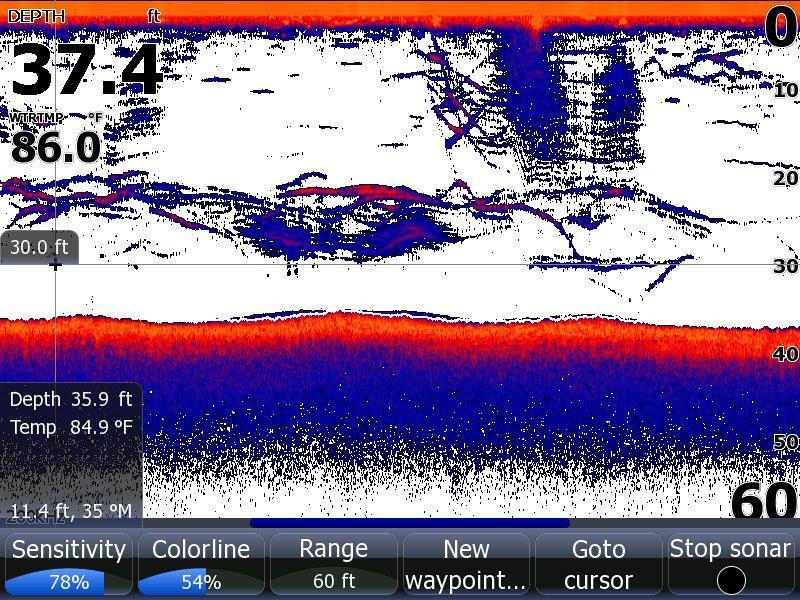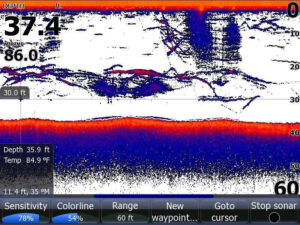The thought of suspended bass can make a grown man shudder. You can see them on your graph, you know where they’re living, but you can’t buy a bite to save your life. You’re not alone—this is a very common frustration among bass anglers. Fortunately, there’s an effective solution to the problem.
Big Bite Baits pro Jeff Kriet is a big believer in fishing with a drop shot for suspended bass. Although many anglers consider bottom contact a necessity for this technique, he’s had a great deal of success without it.
Important signs to look for
Throughout the summer and early fall, bass are notorious for herding big pods of shad into tight balls when feeding. If Kriet is fishing a ledge with a big worm or a football jig and notices bait on his Lowrance, he’ll stop what he’s doing and begin drop shotting.
“I truly believe there are always more fish suspended than there are related to the bottom,” Kriet said. “Unless I’m bed fishing, I’m always watching my Lowrance for any signs of heavy bait activity. Schools of bait will show up as big balls on your sonar, and that tells you bass are nearby. Shad don’t just travel in balls—something is pushing them into that position.”
While he catches plenty of fish drop shotting in the middle of these bait balls, his biggest bass often come from elsewhere. If he notices a ball of bait on his graph, he’ll slowly circle the school looking for big, rogue bass.
“It’s definitely possible to catch big bass simply targeting bait balls, but sometimes the biggest fish tend to hang out away from all of the action,” Kriet said. “If you see arches on your graph that are 10 or 20 yards away from the bait pod, it’s probably a big one.”
How to make the bass eat
Kriet often refers to drop shotting suspended fish as a cat and mouse game. Although there’s not necessarily a wrong way to target these finicky bass, he approaches each situation in a specific manner.
“I start out by positioning my boat right above the bait ball and drop my drop shot directly through the middle of it,” Kriet said. “Many times you’ll see a bass break out of the bait ball and follow your worm to eat it. Most of the time, however, you have to play with them. I’ll reel back up, drop my bait right above the bait, shake it around and then drop it back down through the bait. If you see the bass reacting, you’ll eventually catch it.”
Time management is an essential part of Kriet’s approach. He’d much rather capitalize on the most aggressive schools than waste time on inactive fish.
“Realistically, you’ll probably only catch a couple fish from each school,” Kriet said. “I have a fairly simple rule of thumb when I drop shot for suspended fish—as long as they’re reacting to my presentation on the graph, I’ll keep dropping on them. If they’re ‘flat-lining’ and not paying any attention to your bait, you probably won’t catch them.”
If he runs into a stubborn school of bass, Kriet doesn’t let it fluster him. Instead of trying to force a bite, he’ll simply leave the school and come back to it later in the day. It’s not uncommon to catch a big limit of bass out of a school that was totally inactive earlier in the day.
Your sonar is essential
Most bass fishing techniques are possible without the use of electronics, but drop shotting for suspended bass isn’t really one of them. Kriet keeps his eyes glued to his sonar at all times—almost as if he’s playing a video game.
“It’s very important to have your sonar set correctly,” Kriet said. “In depths over 30 feet, I make sure to set my range from 20 to 50 so I can really key in on the most productive zone. I also turn my ping speed down and increase my sensitivity. If you’re dropping on them in 20 feet or less, however, you can usually run your graph on its normal settings.”
It’s also very important to look at the right spot on your sonar. All too often, anglers have a misconstrued view of what’s really happening under the surface.
“When you’re fishing vertically, the only thing you need to be concerned with is the far right corner of your sonar picture,” Kriet said. “That shows you what is going on at that given time and will allow you to paint a good picture of your worm and weight. If you don’t know where your drop shot is, it’s pointless to drop on them.”
Don’t overlook your worm color or gear selection
According to Kriet, one of the biggest mistakes anglers make when drop shotting is becoming stubborn to a certain color worm. If you’re catching fish in an area and the action stops, don’t leave before trying a few different colors, as color preference often changes from fish to fish.
“I’m always going to have a handful of different color Big Bite Baits Shaking Squirrel Worms next to me on the front deck,” Kriet said. “Drop shotting is a very visually oriented technique, so color really matters. I use 3 colors almost all of the time—Hologram Shad, Kriet’s Magic and Bold Gill. If they don’t eat that, I’m doing something wrong.”
Kriet’s Hydrowave unit has totally changed his approach to suspended fish by stirring up deep bait balls. Although it’s been a huge help to his fishing game, it’s a tool you need to be careful with.
“I usually run my unit in a Shad Frenzy mode with 3 or 4 bars of volume,” Kriet said. “Sometimes, however, it can pull the fish too far up to the boat and make them uncatchable. If you notice that happening, turn your volume down, pause it or turn it to a 30-second loop. As long as they’re 15 to 18 feet under the boat, you can catch them.”
Drop shot setups can get pretty elaborate, but Kriet prefers to keep his rigs as simple as possible. When dropping on suspended fish, he uses a 10-pound HI-SEAS Quattro Braided Line and 6-pound HI-SEAS 100% Fluorocarbon combination and a 12 to 14-inch leader to avoid spooking fish.
He prefers a 7-foot, medium action Falcon T7 Kriet Squirrel Tail Spinning Rod due to its soft tip and strong backbone. When targeting in water deeper than 30 feet, he uses a 3/8-ounce or 1/4-ounce drop shot weight. In depths shallow than 20 feet, he downsizes to a 3/16-ounce weight. A sharp hook is essential for this technique.
“Good hooks are extremely important and you’ll always get more bites nose hooking your baits around suspended fish,” Kriet said. “I use a No. 1 Lazer Trokar Drop Shot Hook almost exclusively. If I’m catching them out of brush piles, I’ll Texas rig my worm on a 1/0 straight shank hook.”
Drop shotting for suspended bass takes a lot of practice to master, but knowing what to look for, how to make the bass eat and understanding your sonar can great accelerate your learning curve. Stay tuned for more drop shot fishing features this summer.












